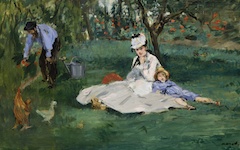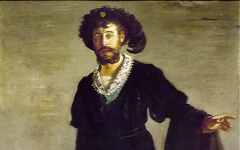Manet’s Olympia (1863) Part 1
Ever since Manet's Olympia (top) was unveiled in Paris in 1865 there have been essentially two ways to explain it. Those with a broad knowledge of art in the West can recognize in the unity of the composition and its forms a modern descendant of reclining nudes in the Venetian tradition and of nudes attended by maids. Works by Titian, Tintoretto, Goya and Ingres have all been cited as precursors and especially Titian's Venus of Urbino which Manet copied as a student. Farwell wrote: "So rich and satisfying are..[Olympia's forms]..that they seem enough to explain the picture's power."1 But are they? Others have focussed more intently on the presumed subject, prostitution. Taking art literally, though, can be as misguided as taking scripture literally or poetry or literary fiction. The superficial subject in art, as I repeatedly show, links the image to contemporary concerns for the entertainment of the contemporary public but does little or nothing to cement the work's stature as a timeless work of art. Here is what I think you should see in Olympia:

Top: Manet, Olympia (1863) Oil on canvas. Musée d'Orsay, Paris
Bottom L: Detail of Olympia;
Bottom R: Detail of Velazquez's Las Meninas
Click image to enlarge.
The black maid behind the nude Olympia is a metamorphosis of Velazquez’s figure behind the Infanta in Las Meninas (lower images), the painting Manet most admired. Both lean to the right. His palette has become her bouquet. Her arms are in a similar pose with the hand at top as the "brush-hand". Charles Baudelaire, Manet's friend, had even described Delacroix’s palette as "an expertly-matched bouquet of flowers."2 With the maid as an "artist", Olympia becomes her "painting" which is why Courbet dismissed Olympia's figure as flat like ‘a playing card’. Paintings are flat; the aging master knew more than he let on.3
Click next thumbnail to continue

Top: Manet, Olympia (1863)
Center: Titian, Venus of Urbino (1538)
Bottom: Detail of Velazquez' Las Meninas (1656)
Click image to enlarge.
Further evidence that the nude Olympia is a "painting" with the black maid as an artist is the title. Though Olympia was a typical pseudonym for a Parisian prostitute, it was also the name of a Roman courtesan whom Velázquez had famously painted though the canvas is now lost. Her name was spelt Olimpia but Manet's allusion is clear: Manet is the new Velazquez.4
Note also how Manet's panel (top) divides the composition down the center as does Titian's in the Venus of Urbino (center). Titian's edge, though, does not catch the light like Manet's. That detail, no writer has seen, refers to the edge of Velazquez's canvas in Las Meninas (bottom).
Click next thumbnail to continue

Top: Gauguin, Caricature of Manet's Olympia (1889)
Bottom: Cezanne, A Modern Olympia II (c. 1873-4)
Click image to enlarge.
This is not exactly a novel interpretation though Manet specialists are unaware of it. Gauguin hung a reproduction of Olympia in his room and drew a caricature of it in 1889 in which the flowers are lined up like blobs of paint on a palette (top); Gauguin's maid is thus an artist.
Cézanne painted two variations titled A Modern Olympia (one below). Both include the artist watching the nude, a clear acknowledgement that an "artist" is present in Olympia. The fruit nearby metaphorically suggests paint; his stick resembles a paintbrush and the top hat was a self-referential synechdoche Manet often used for himself.5
Click next thumbnail to continue
In the 20th century Picasso followed Cézanne in transforming the bouquet of flowers from Olympia into a bowl of fruit, now with a palette-like thumb-hole in it. The painter sits in the foreground like Cézanne while another artist-friend sits behind her with the “palette.” Manet's nude has become black because, in Picasso's fertile imagination, Manet's African painter has painted herself. Note how the nude is unaware of the men.
Click next thumbnail to continue

Top: Detail of Manet, Olympia (1863)
Bottom: Detail of Velazquez, Las Meninas (1656) inverted.
Click image to enlarge.
Olympia meanwhile, with her gaze and flower, recalls Velazquez’s Infanta (bottom) with her's; both heads divided from their torsos by a black line. Note too how the shaded but unusual right-angles of the Infanta's nose and eyebrows are repeated in Olympia but on the other side. They share a similar parting, a narrow mouth and an identical bubble chin. These links become significant once you imagine (correctly) that both females do not look out of the picture but into a mirror, the mirror of the artist's own androgynous mind. Olympia's maid sees what we do. Manet who discovered this method in art and from reproductions of Las Meninas (see its entry) lets viewers uncover this meaning by themselves.
Click on Manet's Olympia Part 2 for further explanation...and, later, on Claus Oldenburg's Pat, Lying as Olympia (1959) for yet another similar understanding of Manet's masterpiece.
More Works by Manet
Find out how the viewer in this garden scene is really inside Manet's mind

Manet’s Monet Family in the Garden (1874)
Notes:
First published online 18 Nov. 2010; revised 16 Dec 2012.
1. Farwell, Manet and the Nude: A Study in Iconography in the Second Empire, PhD Diss. (University of California, Los Angeles) 1973, reprinted by Garland Publishing, p. 210
2. Charles Baudelaire, The Painter of Modern Life and Other Essays, trans. and ed. J. Mayne (Phaidon) 1995, p. 48; Manet did not need the poet to suggest the metaphor and it is doubtful that Baudelaire ever recognized Manet's.
3. Albert Wolff, "Monsieur Manet", Le Figaro-Salon, May 1, 1882 cited in Manet, 1832-1883 (New York: Metropolitan Museum of Art) 1983, p. 182. More recently, Alain Clairet noted that Manet negated perspective by closing the space off close to the foreground thus making Olympia's figure appear 2-dimensional. See Clairet, “Le bracelet de l’Olympia genèse et destinée d’un chef d’oeuvre”, L’Oeil 333, April 1983, pp. 38-9
4. Etienne Delécluze wrote a novel about the famous courtesan painted by Velazquez titled Dona Olimpia [sic] and published it in 1842. However, it was re-published in France in 1862 making the story topical while Manet was painting Olympia. Two critics linked Manet's title with a "famous Renaissance courtesan" at the time, suggesting that readers would have been familiar with the story. Delécluze had used the variant spelling which Manet chose not to follow, probably to make the link less apparent. For more on the Delécluze novel and other explanations of Olympia's name, see Sharon Flescher, “More on a Name: Manet’s ‘Olympia’ and the Defiant Heroine in Mid-Nineteenth-Century France”, Art Journal 45, Spring 1985, pp.27-35. It is, perhaps, also worth noting that Olympia is not a French name. The French for Olympia is Olympe.
Separately, Manet titled both 1863 masterpieces with the title of the painting inside the painting and not, significantly, with a description of the apparent scene: Le Bain, later renamed by others Le Déjeuner sur l'Herbe, and Olympia rather than, say, A Courtesan Receiving Flowers.
5. Manet used a top hat self-referentially in a lithograph for Edgar Allan Poe's The Raven, in Au Café (1878), The Artist: Portrait of Marcellin Desboutin (1875) and Café-Concert de Reichshoffen (1878) and, most notably, in Masked Ball at the Opera (1873-4) among others. He may have been inspired to use it as a self-reference by Delacroix's similar use of a top hat in his iconic painting about the supremacy of French art, Liberty Leading the People (1830).
Original Publication Date on EPPH: 17 Dec 2012. | Updated: 0. © Simon Abrahams. Articles on this site are the copyright of Simon Abrahams. To use copyrighted material in print or other media for purposes beyond 'fair use', you must obtain permission from the copyright owner. Websites may link to this page without permission (please do) but may not reproduce the material on their own site without crediting Simon Abrahams and EPPH.



